Analysis
CA120: New polls show young voters, Latinos key to Dem hopes in November
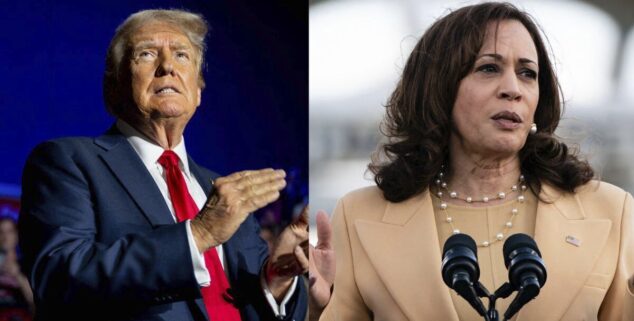 Donald Trump and Kamala Harris. Photo by AP.
Donald Trump and Kamala Harris. Photo by AP.The events of the past week have seemingly turned the Presidential race on its head in a frenetic month of nerve-wracking surprises. The abysmal debate performance from the sitting President Joe Biden, more than a week of prominent Democrats calling for him to drop out of the campaign, or abandon his office entirely, the unthinkable attempted assassination of former President Donald Trump, right before the four-day Republican National Convention, followed shortly thereafter by President Biden’s Sunday afternoon withdrawal from the contest, and less than 30 minutes later his endorsement of his Vice President, Kamala Harris to be the Democratic nominee.
Each of these events have been of a magnitude greater than any “October Surprise” in the past half-century. Yet, surprisingly, each of them has barely fluctuated the national polling more than a few points. Our political polarization is reflected in the sclerotic polling results that barely budge even with the kind of event that, in past elections, should have caused a huge insurmountable shift.
While the results of national and statewide polling are relatively small considering the major shifts in the campaign, we can use our large sample Capitol Weekly poll, with over 5,000 completed surveys, to look at underlying trends that speak to the factors that will be in play as we head toward November.
 This third poll of 1,904 likely California voters was conducted July 25-27th and followed much the same format as our earlier surveys done July 12-14 (N=1,044) and July 19-21 (N=2,121). Some questions are new, reflecting Kamala Harris as the new presumptive Democratic nominee, and some were unchanged, allowing us to better explore the trends through this tumultuous time in the campaign.
This third poll of 1,904 likely California voters was conducted July 25-27th and followed much the same format as our earlier surveys done July 12-14 (N=1,044) and July 19-21 (N=2,121). Some questions are new, reflecting Kamala Harris as the new presumptive Democratic nominee, and some were unchanged, allowing us to better explore the trends through this tumultuous time in the campaign.
First off, in the head’s-up race, Kamala Harris has appeared to consolidate the Democratic vote, pulling voters back from third-party candidates and growing her support by 5-points. This is also an improvement of 7-points from the last Biden-Trump survey result.
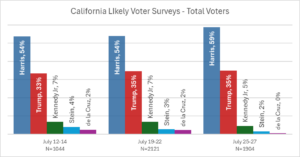
But, despite being an improvement from Biden’s most recent numbers, these numbers are still about 6-points shy of the nearly 30-point 2020 Biden win in California.
Two key parts of the electorate for Democrats, and particularly for the Harris campaign, will be Latinos and younger voters.
In the 2020 Berkeley IGS poll, they found 72% of Latinos supported Biden, compared to 22% for Trump. In our polling we are showing a significant underperformance for the Harris campaign in this important subgroup. And, surprisingly, the elevation of Harris to the presumptive Democratic nominee saw Trump gaining five points in the head-to head while she gained only one point.
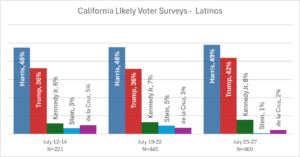
This 42% support for Trump from Latinos – 20-points higher than in surveys in the 2020 presidential election – presents a challenge that could be the biggest blind spot for Democrats in this election cycle – and potentially something they will be unable to fix in the final 100 days.
Among younger voters the Harris campaign has seen massive viral response (and nearly as viral confusion about these viral moments) and we see some of that in the polling, with her picking up 4-5 points in the latest survey. However, Trump is still at record numbers with support from 31% of younger voters. For comparison, in the 2020 IGS Polling, 18-29 year olds were at only 17% while 30-39 year-olds were at 24%.
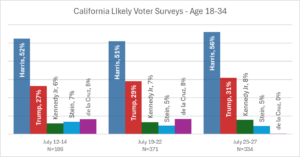
Underlying these topline numbers, our surveys can identify movement in the favorable/unfavorable ratings for Trump and Harris.
For Harris, we see overall improvement in her numbers, from a single-digit favorable rating in the first survey three weeks ago to a +18 in the latest survey.
| Total | 7/12-7/14 n=1,044 |
7/19-7/22 n=2,121 |
7/25-7/27 n=1,940 |
| Favorable | 50% | 54% | 59% |
| Unfavorable | 49% | 46% | 41% |
| Fav/Unfav | +1 | +7 | +18 |
Within subgroups, we see her greatest gains among women (21-points) and Democrats (23-points) as she consolidates those key demographics. But she is also seeing her negative rating among Latinos rise to a plus one-point, and her -30 point deficit in the Central Valley rise to a break-even.
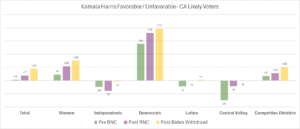
For Trump we see a bit of a different result. Albeit, Trump is not popular in California, but we can see shifts which should help us understand shifts in the rest of the country.
Overall, Trump saw a slight rise in his favorable rating and drop in his unfavorables after the assassination attempt and Republican National Convention – but these numbers were unchanged in the surveys after the Biden withdrawal from the race.
| Total | 7/12-7/14 n=1,044 |
7/19-7/22 n=2,121 |
7/25-7/27 n=1,940 |
| Favorable | 32% | 36% | 36% |
| Unfavorable | 67% | 64% | 64% |
| Fav/Unfav | -35 | -28 | -28 |
The subgroup analysis shows fluctuating numbers, with an initial pickup among men and Republicans and Independents, but this waxed and waned among some groups after Biden dropped out. Consistent with the results in the head-to-head contest, Latinos show more Trump favorability after Harris becomes presumptive Democratic nominee.

Finally, we used the last two surveys to try and dig into more about Harris and Trump, specifically about their perceived fitness for office.
The first question asked if voters felt that each candidate cared about people like them. In this survey question we can see California voters believe Harris cares about people like them more than Trump, but, of course, this is a state with a significant Democratic advantage.
Where we find real value is in looking at subgroups that are in play. For example, among Independents, Trump actually led Harris in this measure for both surveys, before and after she became the presumptive Democratic nominee. Also, among Latinos, Harris started with a small 2-point advantage in this question, but Trump tied her in the second survey.
Among Women, Harris has a massive 53-28 advantage, but among young voters, it is not as clear – with Harris behind Trump in the earlier survey, and ahead by only 8-points in the most recent one.
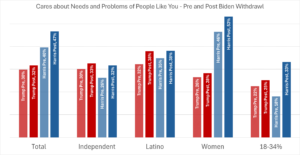
Another attitudinal question hit on if voters thought that each candidate had the temperament to be president. On this question, Harris began, prior to the Biden withdrawal, with an advantage over Trump, but that has grown significantly since she became the presumptive nominee. This growth hasn’t been as strong among Latinos, where she maintains only a small advantage over Trump.
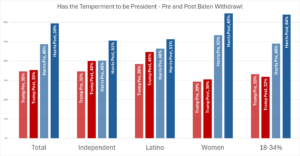
The full crosstabs of these questions, and more questions not covered in this overview, can be found here with the prior two survey crosstabs here and here.
Want to see more stories like this? Sign up for The Roundup, the free daily newsletter about California politics from the editors of Capitol Weekly. Stay up to date on the news you need to know.
Sign up below, then look for a confirmation email in your inbox.

Leave a Reply